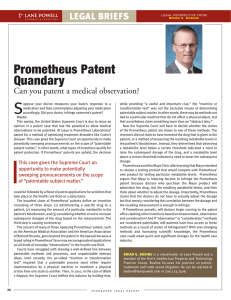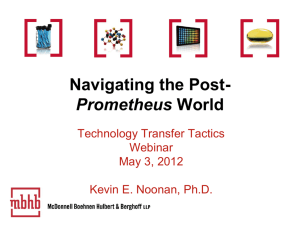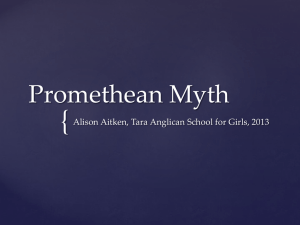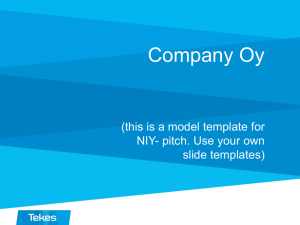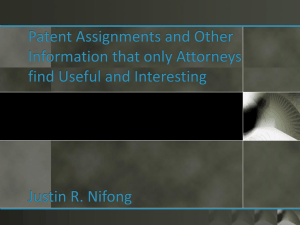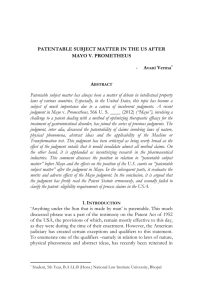Mayo v. Prometheus, 132 S. Ct. 1289 (2012)
advertisement
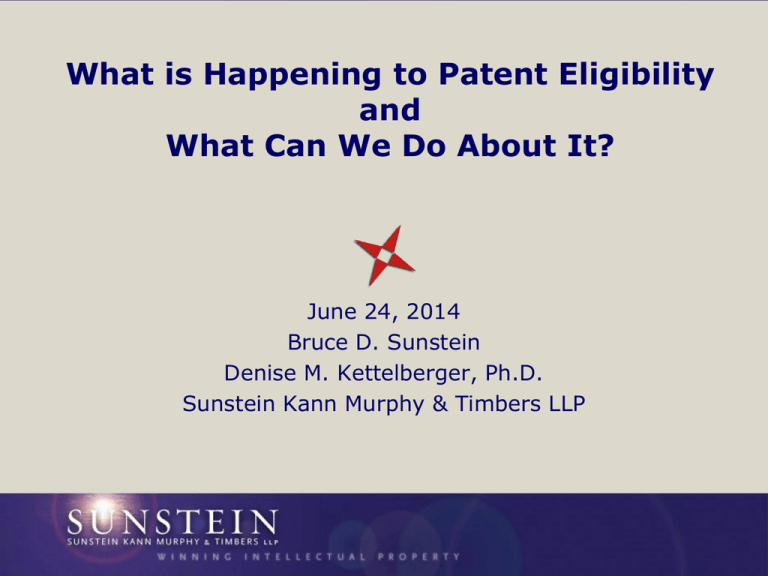
What is Happening to Patent Eligibility and What Can We Do About It? June 24, 2014 Bruce D. Sunstein Denise M. Kettelberger, Ph.D. Sunstein Kann Murphy & Timbers LLP The Phenomenon A recent series of Supreme Court rulings has made a wide range of patents and patent applications ineligible for patent protection These decisions significantly expand the scope of claims ineligible for patenting The rulings cover diagnostic methods, gene sequences, and computer-related inventions 2 The root of the trend: Mayo v. Prometheus, 132 S. Ct. 1289 (2012) The Claims administering a thiopurine drug to a subject with a gastrointestinal disorder, determining the level of a specific metabolite of the thiopurine drug in the subject, wherein a level below a first threshold indicates a need to increase drug dosage, and wherein a level above a second threshold indicates a need to decrease drug dosage. 3 The root of the trend: Mayo v. Prometheus, 132 S. Ct. 1289 (2012) The Holding The claimed subject matter is ineligible for patenting as the claimed processes fail to transform unpatentable natural laws into patent-eligible applications of those laws. Upholding the patents would disproportionately risk tying up use of the underlying natural laws, inhibiting their use in making further discoveries 4 The root of the trend: Mayo v. Prometheus, 132 S. Ct. 1289 (2012) The Theory “the ‘administering’ step simply refers to the relevant audience, namely doctors who treat patients with certain diseases with thiopurine drugs” “the ‘wherein’ clauses simply tell a doctor about the relevant natural laws” the determining step “tells doctors to engage in well-understood, routine, conventional activity previously engaged in by scientists who work in the field”. 5 The root of the trend: Mayo v. Prometheus, 132 S. Ct. 1289 (2012) The Analysis 1. Determine whether the claims are directed to a patent-ineligible law of nature, natural phenomenon, or abstract idea 2. If so, then search for an “inventive concept”— i.e., an element or combination of elements sufficient to “transform” the claimed abstract idea into a patent-eligible application 6 The root of the trend: Mayo v. Prometheus, 132 S. Ct. 1289 (2012) Rationale The Court has “a concern that patent law not inhibit further discovery by improperly tying up the future use of laws of nature” The patent claims here “threaten to inhibit the development of more refined treatment recommendations (like that embodied in Mayo's test), that combine Prometheus' correlations with later discovered features of metabolites, human physiology or individual patient characteristics” 7 The next step: Ass'n for Molecular Pathology v. Myriad, 133 S.Ct. 2107 (2013) Holding: isolated segments of genomic DNA are not eligible for patenting, because gDNA is a natural phenomenon and “separating a gene from its surrounding genetic material is not an act of invention” But preparation of complementary DNA is patent eligible, because it is not a “product of nature” 8 Draft Guidelines from the USPTO, March 2014, in the wake of Prometheus and Myriad Would render ineligible for patenting: Diagnostic tests, isolated DNA segments, many purified naturally occurring substances and mixtures thereof 9 Alice Corp. v. CLS Bank, 6/19/14 Holding The claims “are drawn to the abstract idea of intermediated settlement” [“i.e., the use of a third party to mitigate settlement risk”] “[M]erely requiring generic computer implementation fails to transform that abstract idea into a patent-eligible invention” The subject matter is ineligible for a patent, but computer-related inventions not drawn to an abstract idea may still be eligible. 10 Alice Corp. v. CLS Bank, 6/19/14 Analysis “As stipulated, the claimed method requires the use of a computer to create electronic records, track multiple transactions, and issue simultaneous instructions; in other words, ‘[t]he computer is itself the intermediary.’” The claims here do nothing more than “simply instruct the practitioner to implement the abstract idea of intermediated settlement on a generic computer.” 11 Alice Corp. v. CLS Bank, 6/19/14 Rationale “Laws of nature, natural phenomena, and abstract ideas are the basic tools of scientific and technological work. “Monopolization of those tools through the grant of a patent might tend to impede innovation more than it would tend to promote it, thereby thwarting the primary object of the patent laws.” [citations and interior quotes eliminated] 12 The Court Distrusts the Patent System Ineligibility is linked to purported preemption of scientific research and discovery by patent claims that are said to be drawn to laws of nature, natural phenomena, and abstract ideas In determining eligibility, the specificity of the claims is ignored by generalizing them into an abstraction and then using the abstraction as a core that is ignored in determining whether “significantly more” than the abstraction is present—a subjective exercise that eviscerates the claims 13 Ironically, the Court rewards the clever draftsman “This Court has long warned against interpreting §101 in ways that make patent eligibility depend simply on the draftsman’s art.” Alice, quoting from Prometheus [interior quotes, ellipses omitted] Claims that are atomized into smaller parts, that include more hardware, more non-natural parts, more physical effects, and more detail are likely to be more successful. See Ultramercial v. Hulu, 722 F.3d 1335 (Fed. Cir. 6/21/13)(example of patent claims found not abstract, and in an opinion by J. Lourie, who is hostile to eligibility) 14 What to do?—Pass a law to override Prometheus Add a new sentence at the end of section 101 of 35 U.S.C.: Claimed subject matter that provides a useful, concrete, and tangible result shall not be denied eligibility for a patent on the ground that it is directed to a law of nature, natural phenomenon, or abstract idea, and shall be evaluated in accordance with the other provisions of this title. 15 Thank you. bsunstein@sunsteinlaw.com dkettelberger@sunsteinlaw.com www.sunsteinlaw.com
